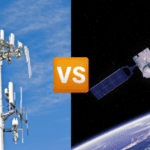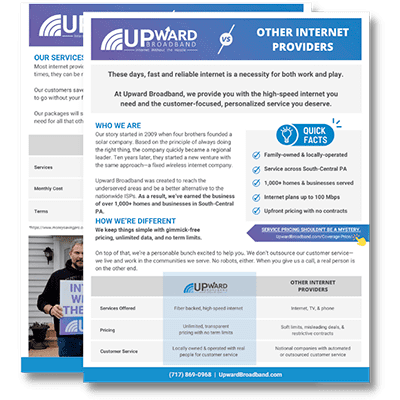If you’re in the market for a new internet service provider, you’ll likely come across a few unfamiliar terms. Their meanings may not be obvious, but knowing them is essential to understanding what you’re dishing out your hard-earned money for.
We’ve been in your shoes, and we know shopping for internet service providers isn’t the most exciting way to fill your time. So in hopes that we can make the experience a little easier and faster for you, we’ve assembled a list of 10 basic internet terms and their definitions. Knowing these words and their meanings should make comparing your options quick and easy.
Key Internet Terms You Need to Know
Bandwidth
Whether you’re streaming your favorite TV show, sending an email, or browsing web pages, everything you do on the internet can be summed up into one action: transferring data.
Bandwidth is how we measure how much data can be transferred from the internet to our computers each second.
Think of your internet connection as a garden hose, except instead of water running through the hose to a watering can, there’s data coming to and from your computer. In this scenario, bandwidth is controlled by how fat the hose is.
The bigger the hose, the more data that can be transferred at once (or the faster you can fill up your watering can). If you have a thinner hose, you’ll still be able to fill up your watering can, it’ll just take a little longer since less water can travel through the hose at once.
Broadband
The FCC defines broadband as internet with speeds of at least 25 Mbps download and 3 Mbps upload. Relative to older forms of accessing the internet (dial-up), broadband is characterized by high speeds and a constant connection.
There are many different options for achieving broadband-level internet speeds. Cable internet, satellite internet, DSL, fixed wireless internet, and fiber could all potentially bring you speeds that meet the FCC’s definition for broadband. However, not all types of internet and not all internet service providers can achieve those speeds in every area of the county.
Because internet infrastructure is expensive, areas with high population densities tend to have the fastest connections and best options. There are more potential customers there, making it easier for the provider to make their money back.
But that approach leaves many rural-area homes and businesses with no access to or very limited access to high-speed internet. And as our usage of the internet increases day by day, that’s becoming more and more of a challenge for those in less populated areas.
If you’re in a rural area and you may simply not have a provider that offers broadband-level service. However, fixed wireless internet is out to change that.
Because the infrastructure for fixed wireless is much less resource-intensive than cable or fiber, fixed wireless providers can service areas with smaller populations, bringing broadband-level options where there may not have previously been.
Bundling
Many internet service providers want to provide their customers with the most services they can, so they also offer television and phone services. In order to sweeten the deal, they’ll roll internet plans together with television and/or voice plans for one monthly price.
Including all of these services together is known as bundling.
If you want cable or satellite TV and a landline, these bundles can sometimes be a good deal. However, if you plan on streaming your entertainment and have a separate cell phone provider, these bundles can be frustrating.
Sometimes, companies that bundle make opting for just the internet seem like a bad deal. For just a few dollars more a month, you could get television and phone service. So whether you really want it or not, shouldn’t you get it anyway?
But if you don’t really want these services, how can they provide them for such a small fee? This makes us question what you’re really paying for.
Coverage Map
Not all companies provide service to all areas. And even if the provider does service your area, there’s no guarantee you’ll be able to get the level of service you want.
Speeds and packages will vary from area to area, and the package you really want may be out of reach for your select area.
Some internet service providers will require you to enter in your zip code, street address, and other information to determine your eligibility.
At Upward Broadband, we try to make determining whether or not we can serve you as easy as possible. Check out our service coverage map. However, to be sure we can serve you, we’ll come out and make sure we can get a direct line of sight from one of our towers.
Data Caps
You may remember from the explanation of bandwidth that everything we do on the internet requires the transferring of data from one point to another point. Some internet providers limit the amount of data you can transfer each billing period. To continue our hose metaphor, that’s like limiting the amount of water you can draw from your hose.
What happens if you go over your data cap?
One option is that your internet service provider will charge you overage fees based on how much you go over. This is often called a “hard” data cap.
The other option is that they’ll throttle your bandwidth, restricting the flow of data which can make your internet seem slow. Some internet providers that throttle your connection may advertise they don’t have a “hard” data cap, which could lead you to think that there’s no data cap.
At Upward Broadband, we don’t have any data caps, meaning you have unlimited data and won’t be charged overage fees or have your bandwidth throttled.
Download Speeds
Download speeds measure how quickly data can get from the internet to your device. It measures how quickly a web page will load once you click on it, or how smoothly a video will play from your streaming service.
Download speeds don’t just apply to things you physically download, like saving an email attachment to your desktop or downloading a song from a music website. They apply to anything you access on the web from your device.
Upload Speeds
We went a little out of alphabetical order here! But download speeds and upload speeds go hand-in-hand, so for the sake of clarity, forgive us!
Upload speeds measure how quickly data goes in the opposite direction—from your computer to the internet. This determines how fast you can transfer a picture from your cell phone to your social media page, or how quickly you can move a file over from your desktop to a cloud storage site like Dropbox.
Both download and upload speeds are measured in megabits per second, or Mbps. You’ll often see them as a pair separated by a slash, like 25/5 Mbps or 50/10 Mbps.
Download speeds will be the first number, and upload speeds will be the second. Internet service providers intentionally make upload speeds slower. This allows them to divert more to download speeds, which is what we’re more likely to need for a smooth and enjoyable experience.
Latency
Latency is related to bandwidth, but it’s not the same thing. Latency is how long it takes for data to go from the internet to you, or vice-versa.
For example, every time you click on something on a webpage or in an app, a signal is sent to the website’s or app’s server. Then, the server responds by sending back the data you requested.
In our house analogy, it’s the length of the hose. The longer the hose, the longer it’ll take to get your water. The higher your Internet connection’s latency, the longer it will take to get your data. For internet that feels fast and responsive, you want low latency.
Modem
A modem is a relatively small electronic device that essentially brings the internet from your provider into your home or business. To get technical, your internet service provider transmits the internet through an analog signal, but your devices need digital internet signals. A modem converts the analog to digital and then transfers it to a router.
Many internet service providers allow you to rent modems from them for a monthly fee. However, you can buy your own, as long as it’s a model that will work with your internet provider.
Depending on your internet service provider, you may not need a modem. You may only need a router.
Router
A router is another relatively small electronic device that connects to the modem. Once connected, it will distribute that digital internet signal to your devices through WiFi and/or ethernet cables.
Like modems, you can rent routers from your internet service provider or buy one from their approved list.
A modem and router can seem a little redundant. At Upward Broadband, you’ll only need a router to connect the devices in your home or business to our fixed wireless internet.
Now You’re a Master at Internet Terminology
Congratulations! You made it through our list of internet terminologies and their definitions.
Hopefully, this will make your shopping for internet providers in your area a little faster and easier.
If you’re in Central Pennsylvania, consider adding Upward Broadband to your list of possible providers! We distribute broadband-speed fixed wireless internet to homes and businesses.
We believe in stellar customer satisfaction, unlimited internet, and up-front, gimmick-free, pricing. And our internet comes unbundled, meaning you only have to pay for what you want.




